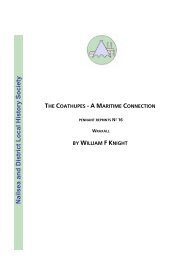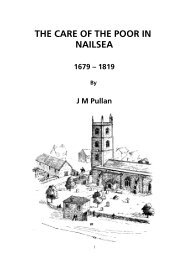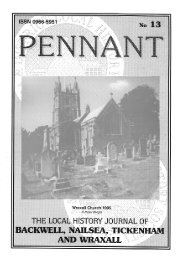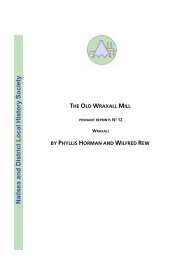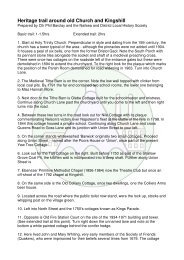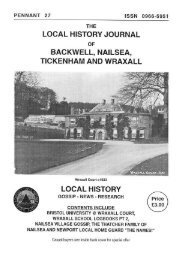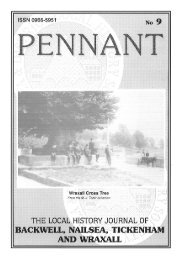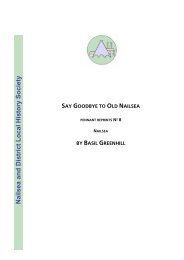No 21 - Nailsea and District Local History Society
No 21 - Nailsea and District Local History Society
No 21 - Nailsea and District Local History Society
- No tags were found...
You also want an ePaper? Increase the reach of your titles
YUMPU automatically turns print PDFs into web optimized ePapers that Google loves.
The crosses come in many different shapes <strong>and</strong> sizes. Square <strong>and</strong> octagonalplans seem to be favoured, but the basic plan is of stone steps, with a socketstone supporting a tall shaft, at the top of which is placed a carved ‘head’usually with a depiction of the crucifixion or other religious scene. Some crossesst<strong>and</strong> in churchyards, some in market places, some on boundaries, <strong>and</strong> a few atprominent road junctions.The meanings <strong>and</strong> uses of the crosses for medieval villagers are even less clear.Pooley’s Victorian imaginings are tinted by a very sentimental view of medievalreligion, but there are clues in documents <strong>and</strong> in the structures themselves. Theclass of crosses on steps in churchyards are obvious centres for ritual, bothformal <strong>and</strong> informal.In modern times the formal use could be likened to the Remembrance DayService where symbols of remembrance (the wreaths) are deposited. Were themendicant friars (beggars) really heard to preach from the cross steps; did thechildren of the village gather to play on the steps, as they do now?Their religious significance, indicated time <strong>and</strong> time again by the subject of thecarvings on their heads, <strong>and</strong> occasionally on shafts <strong>and</strong> sockets, cannot bedoubted, but whether this was the case with village crosses is not so clear.Despite the description of a carved top to Shepton Mallet market cross in theeighteenth century, <strong>and</strong> the frustrating survival of part of the medieval head, atCheddar, we have no definite surviving example of a cross-head from such across unless that on Crowcombe village cross is old..What is almost certain is that all classes of cross have proved magnets asmeeting places for gossip <strong>and</strong> small business ever since they were built <strong>and</strong>, to acertain extent, they still do. It is very likely, however, that the churchyard crossesrepresented a kind of common memorial to all those buried in the churchyard,when many had no or little other memorial.Perhaps the crosses serve as centres to focus the social activities <strong>and</strong> otheractions of the community, both living <strong>and</strong> dead.. Whether the proximity ofsettlements to crosses is significant is unclear: in most cases the settlements willhave existed long before the cross arrived. Whether roads focused on centres ofactivity, later marked by crosses, or whether that activity grew up around thepoints where roads met is a complicated issue.



